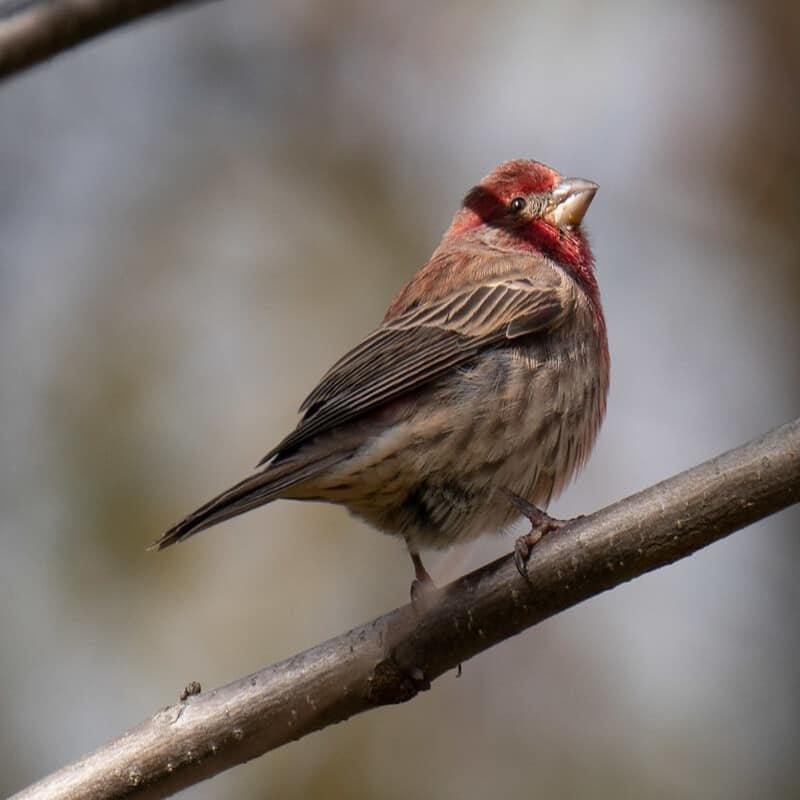The house finch, Haemorhous mexicanus is a finch species belonging to the Fringillidae family. It is indigenous to western North America and has been introduced to the continent’s eastern half and to Hawaii. This species, along with the other “American rosefinches,” is classified as Haemorhous.
Quick Overview: Haemorhous Mexicanus – House Finch
Body size: Around 6 in (15 cm) and a weight of 27 g (0.92 oz)
Main colors: Rosy-Pink, Red, White, Brown
Range: Throughout the United States
Migratory Bird: Yes
Best time of the year to see in the U.S.: All Year (January – December)
Conservation Status: Least Concern
House finch Description
Small songbirds, house finches are. Males’ throats and rumps are rosy-pink. They have a red line across their eyes, lightly streaked redbacks, whitish and brown-streaked abdomens, and brown-streaked wings, sides, and tails. Females are generally brownish in color but may exhibit some pale red pigmentation. Young female house finches resemble adult females.

Size
These birds have a length of 6 in (15 cm) and a weight of 27 g (0.92 oz). Their wings could range from 9.75-10 in (25-25.75 cm).
Feeding
Almost exclusively, these birds feed on grains, seeds, buds, and fruits. Thistle, dandelion, sunflower, and mistletoe seeds are frequently consumed. In the late summer, they enjoy fruits such as cherries and mulberries. House finches will also consume flower parts and will occasionally consume insects such as beetle larvae and plant lice, but these are often consumed in conjunction with seeds.
Habitat
House finches are highly adaptable to urban and suburban environments in the eastern United States. Indeed, they are almost exclusively found in areas with buildings and lawns. Additionally, they are found in the open desert and desert grassland, chaparral, oak savannah, riparian areas, and open coniferous forests throughout their native range in the western United States.
Behavior
During the day, House Finches are active. They are not territorial in any way. Indeed, they frequently nest in close proximity to one another and are frequently found in small groups or flocks. Males and females typically establish hierarchies of dominance in groups, with females typically dominating males. House finches do not migrate across the majority of their range. Certain populations in the eastern United States, on the other hand, migrate to warmer areas during the winter.
Haemorhous Mexicanus Scientific Classification
- Kingdom: Animalia
- Phylum: Chordata
- Subphylum: Chelicerata
- Class: Aves
- Order: Passeriformes
- Family: Fringillidae
- Subfamily: Carduelinae
- Genus: Haemorhous
- Species: Haemorhous mexiicanus
Best time of the year to see
In the United States, the best time of year to see these birds is all year round, regardless of the season. This refers to any month of the year between January and December
Distribution of the House finch in the USA
From southeastern Canada to Mexico, and throughout United States resident. Introduced to eastern North America, where it has become established in urban and suburban areas.
The House finch can be found in the following states in the United States – Alabama, Alaska, Arizona, Arkansas, California, Colorado, Connecticut, Delaware, Florida, Georgia, Hawaii, Idaho, Illinois, Indiana, Iowa, Kansas, Kentucky, Louisiana, Maine, Maryland, Massachusetts, Michigan, Minnesota, Mississippi, Missouri, Montana, Nebraska, Nevada, New Hampshire, New Jersey, New Mexico, New York, North Carolina, North Dakota, Ohio, Oklahoma, Oregon, Pennsylvania, Rhode Island, South Carolina, South Dakota, Tennessee, Texas, Utah, Vermont, Virginia, Washington, West Virginia, Wisconsin, and Wyoming.

